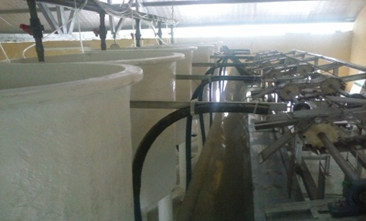Globally, the reduction in availability of feed ingredients, especially fish meal and oil, is considered among the main constraints of aquaculture development (Tocher, 2015; Nguyen et al., 2019a, 2019b). During the last few decades, many studies have been conducted on the replacement of fish oil with plant oils. Linseed, sunflower, and sesame oils may be considered as candidates to replace fish oil based on their high contents in PUFA (Popa et al., 2012; Asghar & Majeed, 2013). Among them, linseed oil has more advantages as it contains a higher level of ALA than the other two oils (Asghar & Majeed, 2013). The combination of different dietary plant oils could provide a better balanced PUFA profile for fish than a pure dietary plant oil (Castro et al., 2016; Kutluyer et al., 2017).
Although recent studies have focused on how fish oil replaced by plant-derived oils influences the bioconversion capacity of common carp, to our knowledge, the digestibility of such dietary lipid sources in common carp has not yet been assessed.
A study was conducted to evaluate the digestibility of different dietary lipid sources in the diet of common carp, and to determine how the PUFA composition of plant oils affects the growth, feed utilization, and tissue FA composition of fish fed these plant-derived oils.
Apparent digestibility coefficients (ADC) of lipids were determined in carp (200.2 ± 40.0g) fed with cod liver oil (CLO), linseed oil (LO), sunflower oil (SFO), or sesame oil (SO). A 96-day growth trial was then conducted using six isolipidic (from 100 to 101 g/kg diet) diets, namely CLO, LO, SFO, SO, and two blends of plant oils (SLO = SO + LO; SSFO = SO + SFO). Lipid ADC values (0.920-0.972) were similar or slightly lower in the plant oil-based diets than in the CLO-based diet. Growth and feed efficiency (FE) were not influenced by dietary lipids. The fatty acid profile in the liver and muscle reflected those of the dietary lipids. The EPA and DHA proportions were higher in the liver and muscle of the LO and SLO-fed fish than in the other plant oil groups, and lower than in CLO-fed fish (P <0.05). Higher EPA, DHA, and n3/n6 ratio levels in the muscle of fish fed on the linseed oil (LO) diet, as compared to those in fish fed on the other plant oil-based diets, were ideal for human health and suggest that it can be used as a suitable alternative to fish oil.
The full paper can be accessed here on Vietnam Journal of Agricultural Sciences (ISSN 2588-1299).
    |
 |
| Digestibility trial experiment system |
References
Asghar A. & Majeed M. N. (2013). Chemical characterization and fatty acid profile of different sesame verities in Pakistan. American Journal of Scientific and Industrial Research. 4: 540-545. DOI: 10.5251/ajsir.2013.4.6.540.545.
Castro C., Couto A., Pérez-Jiménez A., Serra C. R., Díaz-Rosales P., Fernandes R., Corraze G., Panserat S. & Oliva-Teles A. (2016). Effects of fish oil replacement by vegetable oil blend on digestive enzymes and tissue histomorphology of European sea bass (Dicentrarchus labrax) juveniles. Fish Physiology and Biochemistry 42: 203-217. DOI: 10.1007/s10695-015-0130-1.
Kutluyer F., Sirkecioğlu A. N., Aksakal E., Aksakal F. İ., Tunç A. & Günaydin E. (2017). Effect of dietary fish oil replacement with plant oils on growth performance and gene expression in juvenile rainbow trout (Oncorhynchus mykiss). Annals of Animal Science. 17: 1135-1153. DOI: 10.1515/aoas-2017-0010.
Nguyen T. M., Mandiki S. N. M., Gense C., Tran T. N. T., Nguyen T. H. & Kestemont P. (2019a). A combined in vivo and in vitro approach to evaluate the influence of linseed oil or sesame oil and their combination on innate immune competence and eicosanoid metabolism processes in common carp (Cyprinus carpio). Dev. Comp. Immunol. 102: 103448. DOI: 10.1016/j.dci.2019.103488.
Nguyen T. M., Mandiki S. N. M., Tran T. N. T., Larondelle Y., Mellery J., Mignolet E., Cornet V., Flamion E. & Kestemont P. (2019b). Growth performance and immune status in common carp Cyprinus carpio as affected by plant oil-based diets complemented with β -glucan. Fish Shellfish Immunol. 92: 288-299. DOI: 10.1016/j.fsi.2019.06.011.
Popa V.-M., Gruia A., Raba D.-N., Dumbrava D., Moldovan C., Bordean D. & Mateescu C. (2012). Fatty acids composition and oil characteristics of linseed (Linum Usitatissimum L.) from Romania. Journal of Agroalimentary Processes and Technologies. 18: 136-140.
Tocher D. R. (2015). Omega-3 long-chain polyunsaturated fatty acids and aquaculture in perspective. Aquaculture. 449: 94-107. DOI: 10.1016/J.Aquaculture.2015.01.010.